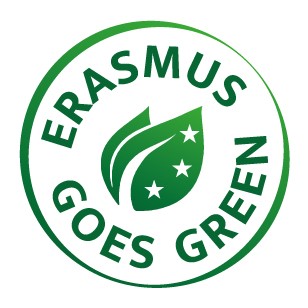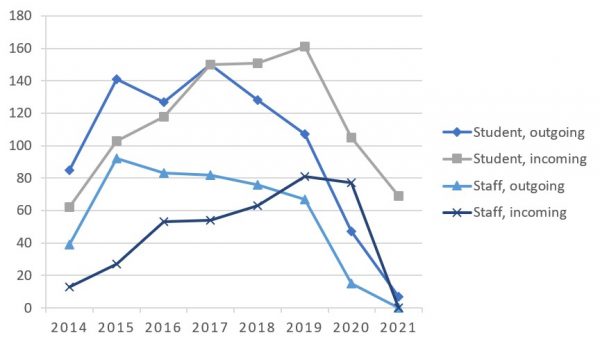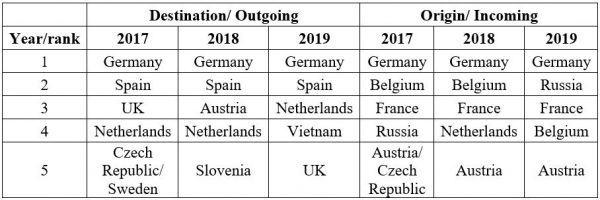Sirpa Kokko, M.Sc. (Tech.), Project manager, Arctic Natural Resources and Economy, Lapland University of Applied Sciences
Henri Saarela, M.Sc. (Tech.), Project engineer, Arctic Natural Resources and Economy, Lapland University of Applied Sciences
Introduction
One of the most popular ways to study and work abroad in Europe is to participate Erasmus+ programme. 90 000 Finnish students have completed a student exchange and 13 000 students a traineeship in Europe over a period of more than 30 years. 120 000 incoming higher education students have participated Erasmus+ programme in Finland in 30 years. About 2000 staff members of Finnish higher education institutes participate in Erasmus+ programme every year. (Finnish National Agency for Education 2021)
Erasmus+ programme is a European funding programme, that was established in 1987 (Erasmus Student Network 2021). It offers students, staff, trainees, teachers and volunteers to study, teach, do internship, and volunteer abroad. The newest Erasmus+ programme is for the years 2021–2027. Number of participants in the budget is 10 million, which is 2,5 times bigger than the budget of the programme 2014–2020. Priorities of the new programme are inclusion and diversity, digital transformation, environment and fight against climate change, and participation in democratic life. The programme encourages to participate in the new feature of the programme: blended mobility, which is a combination of physical mobility and virtual study component. The programme encourages and finances to choose “greener” transportation means when travelling to and from the destination country. (European Commission 2021)
To ensure sustainable growth of the Erasmus+ programme, Erasmus Goes Green -project is one of the actions that was started. Lapland University of Applied Sciences is one of the project partners in the project. (Grant award decision 2020)
Erasmus Goes Green -project
Erasmus Goes Green -project aims at lowering impact the Erasmus+ programme has on the environment. Main objective of the project is to find solutions to reduce the transport-related carbon footprint of higher education students and staff taking part in Erasmus mobility. Logo of the project is shown in the Figure 1. (Erasmus Goes Green 2021)

Figure 1. Logo of the project
The project has started in October 2020 and will continue until the end of November 2022. Budget of the project is 281 760 €, of which 41 640 € is the share of Lapland UAS. (Grant award decision 2020)
Partners
There are seven partner organisations working in the project, of which five are universities. The universities are Lapland University of Applied Sciences (Finland), Aristotle University of Thessaloniki (Greece), University of Lodz (Poland), Erasmus University Rotterdam (the Netherlands), and Université de Versailles Saint-Quentin-en-Yvelines (France). Other partner organisations are Erasmus Student Network (Belgium), which is the largest student network in Europe, and the European University Foundation (Luxembourg), which is a network of more than 60 universities in Europe. Project coordinator is Université de Versailles Saint-Quentin-en-Yvelines. (Grant award decision 2020)
Tasks
There are four intellectual outputs (IOs) in the project. Main tasks in the IOs are to assess transport-related carbon footprint of the Erasmus+ programme 2014–2020, forecast carbon footprint of the Erasmus+ programme 2021–2027, develop CO2 visualisation tool to help students and staff to reduce carbon footprint of their mobility, research options for offsetting carbon emissions, and wrap up results of the project into policy recommendations and guidelines. (Erasmus Goes Green 2021, Grant award decision 2020)
Lapland UAS has two main tasks in the project. First task is to produce a forecast of the carbon footprint of the Erasmus+ programme 2021–2027. The forecast presents three scenarios: lower emissions scenario, average scenario and higher emissions scenario. Another task is to research solutions for carbon-offsetting. Taking location of Lapland into consideration, Lapland UAS wants to bring an arctic perspective in offsetting options. Lapland UAS also participates in testing the CO2 visualisation tool. (Grant award decision 2020)
Lapland and Erasmus+ programme 2021–2027
When it comes to the number of mobilities in Erasmus+ programme 2014–2020, Finland appeared more as a receiving country than a sending or balanced country (Gabrielczak & Sokolowicz 2021). Lapland University of Applied Sciences and Lapland University represent only a small part of the Finnish universities to where foreign exchange students come to study. But Lapland can play a bigger role than only that share of all exchange students, who enroll at Lapland universities. Lapland has a huge charm among all exchange students regardless the host university in Finland (Talvitie 2021)
Timetravels is travelling company, who organizes group trips to both Finnish and Swedish Lapland. Approximately 10 000 exchange students travel to north via Timetravels. (Talvitie 2021). This is only a number of one company. Lapland in Finland is seen as “must-see” place (Talvitie 2021). It indicates that Erasmus+ programme exhibits Lapland greater way than only the actual number of exchange students of Lapland universities.
When it comes to Finland, Lapland and carbon footprint, we cannot change our remote geographical location in Europe. What we can do, however, is to provide exchange students a country with a well working public transportation system. If one doesn’t want to travel by time-consuming bus or train (for example travelling from Helsinki to Lapland, or vice versa), one can simply choose a night train with a bed: go to sleep on the train in the evening and wake up in Rovaniemi next morning. How simple and smart! Also from the carbon emission point of view.
Importance of calculating carbon footprint
Carbon footprint indicates the total amount of greenhouse gases caused by an individual, organisation, event or product (Carbon Trust 2018). People and organisations are being more and more aware of the climate change and how they can tackle it. Calculating carbon footprint is the first step to start reducing emissions. Carbon footprint calculation indicates the amount and the sources where the emissions come from. Based on the calculations, organisations can make their own conclusions about emissions and their source and allocate reduction actions to the most important and effective actions in their own operation. (UseLess 2020) Reducing existing emissions is the most important way to reduce the size of carbon footprint. After the reducing actions have been made, second best option is to compensate the emissions: make offset actions. (Greencarbon 2021) Offset means that calculated emissions can be compensated by doing some extra action (with money) to reduce emissions somewhere else. One typical example is to plant trees, that are carbon sinks. (Puuni 2019)
Mobilities of students and staff in Lapland UAS
The number of international mobilities of UAS students in Finland has declined since 2016 (Finnish National Agency for Education 2019a). The same pattern can be seen in the number of mobilities of Lapland UAS students (Fig. 2). The number of mobilities should increase, as the budget of participants increases significantly in the new programme. There is a slow start in the new Erasmus+ programme because of the COVID-19 pandemic. In Lapland UAS, there is no incoming nor outgoing mobility in the fall semester 2021.

Figure 2. Mobilities of students and staff in Lapland UAS
Carbon footprint of mobilities of students in Lapland UAS
The most popular countries for students of Lapland UAS to study and do traineeship are Germany, Spain and the Netherlands, as seen in Table 1. These three destination countries are the same as where university students in Finland go (Finnish National Agency for Education 2019b). Popular destinations among Lapland UAS students are also the UK, Austria and Czech Republic.
Table 1. TOP5 countries of outgoing and incoming students in 2017–2019

*Data of the table includes study and traineeship, all exchange programmes
TOP5 countries of the incoming students in Lapland UAS are Germany, Belgium, France, Russia and Austria. Germany is the biggest sending country to Lapland UAS and to all universities in Finland. Belgium is number two in the list of the sending countries to Lapland UAS, but not until number seven in the list to all universities in Finland. (Finnish National Agency for Education 2019b).
To calculate carbon footprint of mobility, distance of mobility is multiplied by emissions factor. The factor depends on means of transportation. The smallest factor is for coach and train, and the biggest for long-haul flight. Carbon footprint of mobility of incoming and outgoing students and staff in Lapland UAS is always big, due to location of Lapland. “Island-like” and faraway location forces participants to choose airplane as means of transportation, when travelling Central and Southern Europe. Nordic countries, though, are accessible by coach and train.
Acknowledgement
Ms. Sanna Juotasniemi in the International Services in Lapland University of Applied Sciences is acknowledged for providing data of mobilities of students and staff in Lapland University of Applied Sciences.
Literature
Carbon Trust. 2018. Carbon footprinting guide. 5.10.2021 https://www.carbontrust.com/resources/carbon-footprinting-guide
Erasmus Goes Green 2021. 24.9.2021. https://www.egg-project-eu.uvsq.fr/overview-of-the-project
Erasmus Student Network 2021. Erasmus+ programme. 24.9.2021. https://esn.org/erasmus
Gabrielczak, P. & Sokolowicz, M. 2021. Assessment of the transport-related carbon footprint of the Erasmus+ programme. The carbon footprint of the Erasmus programme 2014–2020. University of Lodz. 5.10.2021.
Grant award decision 2020. Erasmus Goes Green -project. 187 p.
Green Garbon. 2021. Ensin pitää vähentää ennen kuin voi kompensoida. Green Carbon. 5.10.2021 https://greencarbon.fi/kompensointi/
European Commission 2021. Erasmus+ programme guide. 328 p. 24.9.2021. https://ec.europa.eu/programmes/erasmus-plus/sites/default/files/2021-erasmusplus-programme-guide_v3_en.pdf
Finnish National Agency for Education 2019a. International mobility periods of students in Finnish higher education institutions 2010-2019, universities and universities of applied sciences (UAS) separately. 23.9.2021. https://www.oph.fi/sites/default/files/documents/ENG%20kokonaism%C3%A4%C3%A4r%C3%A4t%202010-2019.pdf
Finnish National Agency for Education 2019b. Top 15 of destination and home countries of mobility periods lasting over 3 months 2019. 23.9.2021. https://www.oph.fi/sites/default/files/documents/ENGtop%20kohde-%20ja%20l%C3%A4ht%C3%B6maat%202019.pdf
Finnish National Agency for Education 2021. What is Erasmus+ for higher education in 2021–2027? 7.9.2021. https://www.oph.fi/en/programmes/what-erasmus-higher-education-2021-2027
Puuni. 2019. Usein kysyttyä. Puuni. 5.10.2021. https://puuni.fi/usein-kysyttya/
Talvitie, M. 2021. Vaihto-opiskelijoiden epäonnisen Lapin reissun järjestäjä: “Harmittaa vietävästi” – ketjussa jo parikymmentä tartuntaa. Yle. https://yle.fi/uutiset/3-11834245
UseLess. 2020. 5 syytä, miksi hiilijalanjälki kannattaa laskea. UseLess. 5.10.2021. https://useless.fi/5-syyta-miksi-hiilijalanjalki-kannattaa-laskea
Key words: mobility, carbon footprint, Erasmus and Lapland